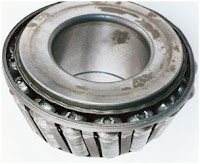Statistics concerning the causes of premature end of life of these elements
are the following:
 |
| Chart on the causes of premature degradation of bearings |
A premature end of life of the bearings means an additional expense for the
customer, since they are expected to last as long as the vehicle, although for
the reasons above this is not always the case.
CONTAMINATION:
 |
| Bearing contaminated by foreign particles |
Contamination by foreign particles can cause problems with the correct
operation of the bearings.
Dust, dirt or any kind of foreign particles can affect the lubrication of
the bearings.
Water is a particular contaminating agent; an amount of 1% water in grease
or oil can mean reduced lubricant life. Humidity and water contamination
produce a chemical attack and corrosion in the bearings.
IMPROPER
LUBRICATION:
 |
| Bearing damage due to improper lubrication |
Improper lubrication is the main reason for bearing fatigue. Improper
lubrication can be caused by: overfilling, underfilling, incorrect
specification, mixture of various lubricants, incompatibility, incorrect
lubrication and irregularities in the replacement intervals (needle bearings,
crankshaft semi-bearings), deterioration of grease or oil, water and
contaminating particles.
The manufacturer should select the type of lubricant according to the
bearing and its use.
Damage caused by poor lubrication may have the following symptoms:
a) Discoloration or darkening: this
appearance of the bearing is due to the contact of metal with metal at high
temperatures. In mild cases, discolouration in the tracks and the rollers is
common, as these surfaces have contact with each other. In extreme cases, heat
discolours the metal itself.
 |
| Bearing discolouration due to lack of lubrication |
b) Scratches:
this is the start of a serious lubrication problem, due either to lack of
lubrication or to an excessive temperature at which the lubricant is unable to
keep the lubricating film. Both cases require immediate attention. These
scratches have the appearance of cuts in the metal.
 |
| Degradation of the bearing with material detachment |
The heat caused by high temperatures located at a particular point, may
also cause deformation of the bearing geometry, which results in asymmetrical
rollers, destruction of the cage, a transfer of metal, loss of torque and power
and an inadequate contact of the bearing.
c) Overload: An
overload of the bearings can be caused by excessive load, excessive turning
speed, high temperature, malfunction or misadjustment. The higher the overhead,
the shorter the durability of the bearing.
 |
| Bearing damage due to overload |
Overload symptoms are: noise, vibration, abnormally high temperatures, swarf and decreased performance.
The bearing must be replaced whenever any overload symptoms are
detected, so as to avoid serious subsequent damages (cracks in the bearings
themselves or their guides, deformation and scratches).
INCORRECT
HANDLING AND INSTALLATION:
Technicians must have knowledge about the proper methods for installing
bearings, as well as having available the necessary tools.
Another premature bearing damage can be caused by improper storage. Before
installing, the technician should make sure that the bearing is supplied in an
anti-corrosive packaging and in good condition.
During
installation, the technician's tool must all be clean. The lubricant layer the
bearing is supplied with should be maintained and not removed.
 |
| Damage due to improper installation |
Poor handling or using improper tools can cause burrs which result in an
incorrect seat, which can increase contact stress at a certain point,
exponentially shortening the durability of the bearing, as it is subject to
irregular loads, torque increase and even excessive temperature.
It should not be forgotten that many bearings are made of steel, bronze or
brass, so that they can be easily damaged if not handled properly.
ADVICE
Currently, damage to bearings is less frequent due to improvements in their
design, training of technicians and sellers, but it is always good to know what
the most common causes of damage are and how to prevent them.
Good lubrication and adequate insulation from contaminating agents, prevention of overloading and proper handling are essential to extend their
durability and prevent
further damage.
The following are two practical tips to reduce contamination:
a) When inspecting a bearing, it is advisable to
clean the surrounding area to avoid contaminants.
b) When replacing a bearing, the surrounding
area should also be kept clean, as well as the location where it is to be
installed. It is advisable to coat the bearing with a thin layer of oil before
installation.


No comments:
Post a Comment